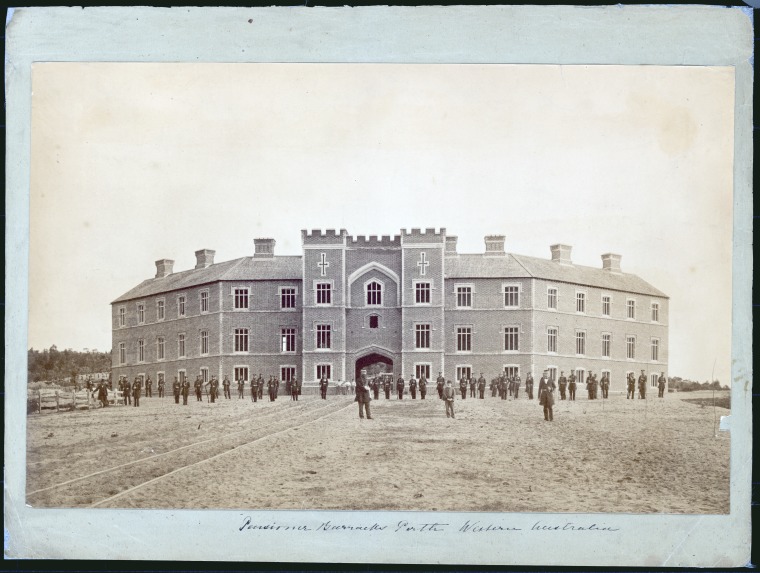The story behind Perth’s ‘Arc de triomphe’

In the western end of St Georges Terrace in Perth, Western Australia, stands a red-brick archway that resembles a Tudor castle. This arch is the last remnant of the Pensioner Barracks, built in 1866 to house the Enrolled Pensioner Force, or pensioner guards. These were British soldiers employed to guard convicts during transportation to WA. They were retired or injured military personnel, typically aged in their early 20s to late 50s, who’d served in colonial wars in South Africa, Crimea, China, India, Persia, Afghanistan or New Zealand, and received a pension from the British government.
More than 1000 pensioner guards arrived in Perth between 1850 and 1868, accompanying the 9000 convicts who arrived in WA during that period.

WA’s decision to transition from a free-settler colony to a penal settlement was a controversial one. The colony was established in 1829 by private capital, and its convict-free status made it the attractive choice for Britons wanting to emigrate to Australia.
But pioneer life proved far from rosy, and the WA colony’s early years were marked by crop failures, labour shortages, a lack of infrastructure and frontier conflicts. From 1833–1834, its population halved as people left for the eastern colonies, and the fledgling settlement continued to flounder during the Australia-wide economic depression of the 1840s.

The future of the WA colony looked bleak. But there was a practical solution to improving its workforce and infrastructure: bring in convicts to work on farms and construct roads, bridges and public buildings.
Not everyone, however, welcomed this decision. In 1849, Perth’s Inquirer journal reported “a revulsion of public feeling with regard to the introduction of convict labour … It was a source of pride and congratulation that Western Australia was free from the moral plague spot that disfigured some of her neighbours”. Convicts were seen as a threat to public safety. Employing pensioner guards helped address concerns by increasing the number of soldiers.
On 1 June 1850, the barque Scindian brought 75 convicts and 55 pensioner guards to WA. Also on board were 29 wives and some 79 children. It was the first of 37 ships that brought convicts and pensioner guards to WA.
Historic records reveal pensioner guards were as varied and colourful as the convicts they were sent to supervise. Some abandoned their duties soon after arriving in the colony, while others went on to have distinguished careers in WA’s nascent police force. Some abandoned their wives and children, leaving them to eke out a living in a colony that offered scant employment opportunities for women. Many abandoned wives, including those who became widows, were sent to Perth’s poor houses.
Convicts helped boost the struggling workforce and economy of the WA colony, whose population had swelled by the 1860s to 17,000, which included 9700 convicts. These worked on farms and developed the colony’s infrastructure by constructing roads, bridges and buildings such as Government House and Fremantle Prison.
In 1866, convicts completed the Pensioner Barracks, a building designed by architect Richard Roach Jewell that included dormitories, 21 married quarters, a wash house, gun room, outdoor firing range, cook house, stables, stores and even a ball court.


Image credits: shutterstock; courtesy of State Library of Western Australia
After six months of full-time service, the guards remained ‘on call’ and were required to parade a minimum of 12 days each year. They became eligible for a free land grant after seven years’ service, so many remained in Australia as free settlers.
The Enrolled Pensioner Force was officially disbanded on 10 November 1880, although some retained employment at Fremantle Prison and Government House. From 1900, the Pensioner Barracks building was converted into offices for the Public Works Department.
The Pensioner Barracks’ wings were demolished in 1966, following a controversial move to provide unobstructed views of Parliament House and allow additional space for construction on the Mitchell Freeway, which began the following year.





